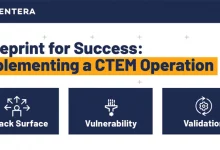Securing Cybersecurity In India: Challenges And Solutions
While it would be ideal for businesses to be impervious to cyberattacks, the reality is quite different. A recent report has shed light on the state of cybersecurity in India, revealing that organizations in the country have only managed to fend off 58% of cyberattacks in the past two years. This highlights the concerning fact that 42% of cyberattacks have been successful.
This leads us to ask: is there any way to reduce the success rate of these cyberattacks?
In this article, The Cyber Express delves into the factors contributing to India’s high cyberattack success rate, featuring insights from cybersecurity experts who propose recommendations for improving the situation and outline the key essentials for effective cyberattack prevention.
India’s Cybersecurity Challenge
A report by Tenable®, Inc. has shed light on a concerning aspect of cybersecurity in India. Indian businesses are succeeding in preventing only 58% of cyberattacks, with the remaining 42% breaching their defenses, forcing heavy reliance on reactive measures.
One prominent issue stems from the misalignment of goals between IT and security teams, with around 71% of organizations prioritizing IT uptime over patching and remediation. This misalignment results in a noticeable lack of coordination.
The adoption of third-party software-as-a-service applications adds complexity to the situation. A significant 81% of organizations employ third-party programs, but merely 54% possess visibility into these third-party environments, impeding proactive security measures. These findings highlights the immediate need for a more coordinated and proactive approach to cybersecurity in India.
In parallel research by Cloudflare, a striking revelation emerged within the cybersecurity realm. An astonishing 83% of Indian organizations surveyed reported at least one cybersecurity incident in the past year. Even more alarming, 48% of these organizations faced not one or two, but an onslaught of ten or more incidents during the same period, transforming the threat into an immediate challenge.
These incidents took on various forms, akin to stealthy predators: web attacks probing vulnerabilities, phishing attempts aiming to deceive and conquer, and supply chain breaches infiltrating the lifelines of these organizations.
The most common cyberattacks organizations face include phishing attacks, ransomware, distributed denial of service (DDoS) attacks, and insider threats,” elucidated Binod Singh, CEO and Chairman of Cross Identity. “Phishing remains a primary concern, as it often tricks individuals into divulging sensitive information, while ransomware attacks encrypt critical data for extortion.”
Kartik Shahani, Country Manager for Tenable India, shed light on the sectors more susceptible to cyberattacks. He pointed out that critical infrastructure is highly vulnerable due to its role in delivering essential services, such as power and water.
However, in recent times, cybercriminals have broadened their targets, encompassing businesses of all sizes and industries. This shift emphasizes the pivotal role of cybersecurity in risk management for all organizations.
As the digital threat landscape in India continues to evolve, the question becomes more pressing than ever: why do these organizations find themselves defenseless against a substantial 42% of cyberattacks, seemingly unable to fend off the ever-encroaching shadow of cyber threats?
Cybersecurity in India: Why 42% Escape Prevention
The enigma of why 42% of cyberattacks manage to slip past defenses becomes clearer when we delve into the intricate challenges faced by Indian organizations. As articulated by Singh, “Organizations grapple with a multitude of obstacles, ranging from budget constraints and limited cybersecurity expertise to the management of complex IT environments and countering rapidly evolving threats. Aligning security practices with overarching business goals presents yet another formidable challenge.”
Singh’s insights shed light on the uphill battle organizations are fighting, where the ever-shifting landscape of cybersecurity threats meets limited resources and expertise.
Expanding on this intricate web, Shahani points to key factors contributing to the surge in cyberattacks. This includes the growing reliance on interconnected devices for process automation and operational efficiency, which significantly expands the threat landscape.
Additionally, economic downturns have forced many organizations to tighten their budgets, which affects their ability to defend against the ever-evolving cyber threats. Moreover, the emergence of ransomware-as-a-service has become a substantial contributor to the rise in cyberattacks.
This model has afflicted organizations across various sectors, making potent ransomware tools more accessible, even to those with limited technical skills. This dynamic has led to attacks that could result in significant financial losses for organizations.
This intricate tapestry of challenges underscores the need for organizations to adopt a proactive and comprehensive approach to cybersecurity in India.
Fortifying Digital Defenses: A Journey to Cybersecurity Resilience
In the ever-shifting realm of cybersecurity, organizations face a daunting task: navigating the intricate landscape and safeguarding their digital assets against the ever-present threat of cyberattacks. But fear not, for there is a roadmap to fortify your digital defenses and minimize the risk of falling prey to cyber threats. This journey begins with introspection, a thorough examination of your organization’s current cybersecurity posture.
As Singh astutely observed, “Organizations must be aware of data protection regulations like GDPR and industry-specific compliance standards. Compliance helps establish a baseline for cybersecurity practices and data protection.” By adhering to these standards, organizations can lay a solid foundation for their cybersecurity efforts.
To identify and address potential vulnerabilities, embark on a regular cadence of security assessments. Employ tools that simulate cyberattacks, exposing weaknesses in your defenses and providing valuable insights into how to strengthen them. Consider enlisting the expertise of cybersecurity professionals to conduct comprehensive audits and tailor solutions to your specific needs.
Shahani emphasized the importance of exposure management, stating, “Exposure management empowers organizations to fortify their defenses, proactively detect and thwart attacks, staying ahead of threat actors. It’s a proactive security strategy that’s indispensable for modern organizations.” By adopting exposure management practices, organizations can uncover hidden vulnerabilities, prioritize cyber risks effectively, and bolster their defenses to intercept attacks before they can infiltrate further.
Remember, cybersecurity in India is not a one-time endeavor; it’s an ongoing commitment to vigilance, adaptability, and continuous fortification. By regularly assessing your defenses, adopting robust exposure management practices, and staying abreast of evolving threats, you can navigate the cybersecurity maze effectively and protect your organization from the ever-present threat of cyberattacks.
Technology at the Rescue
In the relentless battle against cyber threats, technology emerges as a steadfast ally, offering innovative solutions to fortify India’s digital defenses. Treat intelligence and monitoring solutions like Cyble Vision take center stage, offering a lifeline to organizations striving for resilience.
As Shahani aptly pointed out, “Threat intelligence and monitoring solutions can help organizations understand cyber risk and proactively prioritize remediations. Effective threat intelligence requires cybersecurity teams to sift through data, examine it contextually, spot problems, and deploy solutions to reduce risk.”
To pave the way for a more secure digital future, organizations must embrace platforms that consolidate preventive security data into a unified data lake. This consolidated approach empowers security teams to grasp the underlying context of each vulnerability and misconfiguration. In turn, this simplifies the process of securing critical assets and significantly enhances the prospects of preventing cyberattacks before they take hold.
As the cyber landscape continues to evolve, strategies like Zero Trust gain prominence, where trust is replaced by continuous verification. A robust Identity and Access Management (IAM) system plays a pivotal role, enabling organizations to adapt to evolving threats in real time. It does so by offering adaptive access controls, robust authentication methods, and continuous monitoring.
Adequate preparation doesn’t stop at prevention; it extends to incident response. As Singh highlights, “Implementing effective incident response plans is crucial.”
When it comes to cybersecurity, having a comprehensive response strategy is akin to having a fire extinguisher – you hope never to need it, but when a crisis arises, it becomes an invaluable tool in mitigating damage and swiftly recovering from the onslaught.
Looking Ahead: A Secure Digital Future
As we navigate the ever-evolving landscape of cybersecurity, the path to a secure digital future emerges, guided by strategic investments and collaborative endeavors. The imperative is to strike a balance between financial prudence and security, prioritizing investments based on risk, as underscored by Shahani.
The approach involves assessing the potential impact and likelihood of threats, and directing resources to areas with the highest vulnerability and potential consequences.
The partnership between the CFO and CISO, as emphasized by Shahani, aligns cost optimization, performance enhancement, and risk reduction with core business needs.
This entails tool consolidation and sprawl reduction, enhancing operational efficiencies through a unified platform approach that consolidates security functions.
Organizations have the tools at their disposal, as highlighted by Singh, to fortify their cybersecurity posture. With a defense-in-depth strategy, regular security awareness training, and robust identity and access management, they can strengthen their defenses.
Success stories of resilient companies serve as a source of inspiration, demonstrating the efficacy of proactive threat hunting, threat intelligence sharing, and the principle of least privilege.
In the pursuit of a secure digital future, organizations not only safeguard their data and systems but also secure the trust of their stakeholders.
Cybersecurity in India needs to be improved, especially amid the ongoing cyber battle. The strategies, technologies, and collaborations established today will pave the way for a more secure and resilient digital landscape tomorrow.





